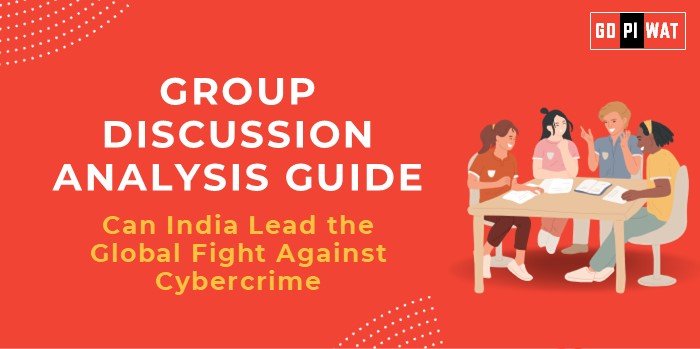📋 Group Discussion (GD) Analysis Guide: Can India Lead the Global Fight Against Cybercrime?
🌐 Introduction to the Topic
💻 Opening Context: As technology advances globally, cybercrime has emerged as a significant challenge, with countries battling data breaches, ransomware, and state-sponsored hacking. India, with its burgeoning digital ecosystem, is at the forefront of this battle.
🌍 Topic Background: Cybercrime costs the global economy over $6 trillion annually, projected to rise to $10.5 trillion by 2025. As a digital hub, India’s role in combating this threat is pivotal. India’s ambitious digitalization, like the Digital India initiative, makes its cybersecurity infrastructure a critical focus.
📊 Quick Facts and Key Statistics
- 📈 Cybercrime Rise: Cybercrime cases in India increased by 11.8% in 2023 (NCRB).
- 🌐 Global Ranking: India ranked among the top 10 countries affected by cybercrime in 2023 (Kaspersky).
- 💸 Breach Costs: The average cost of a data breach in India was ₹17.9 crore in 2023 (IBM Report).
- 👩💻 IT Professionals: India has over 4.7 million IT professionals, a potential global asset in cybersecurity.
🎯 Stakeholders and Their Roles
- 🏛️ Government: Develops and enforces cybersecurity policies (e.g., CERT-In, NCCC).
- 💼 Private Sector: Innovates solutions and strengthens defenses (e.g., IT giants like TCS, Infosys).
- 🧑💻 Citizens: Adhere to cybersecurity practices to safeguard personal data.
- 🌍 Global Organizations: Collaborate on global frameworks, such as the UN’s cybersecurity initiatives.
🏆 Achievements and Challenges
🔑 Achievements
- ✔️ Policy Initiatives: Launch of the National Cyber Security Policy 2013 and updates.
- 📡 Institutional Frameworks: Establishment of CERT-In to respond to incidents and foster awareness.
- 🌐 Global Engagement: Participation in international cybersecurity dialogues like the UN GGE.
- 🔒 Secure Systems: Implementation of Aadhaar encryption, ensuring security for over 1.3 billion citizens.
⚠️ Challenges
- 📉 Infrastructure Gaps: Limited cybersecurity resources for small businesses.
- 👨💻 Talent Shortage: Despite a large IT workforce, specialized cybersecurity professionals are insufficient.
- 🌍 Regulatory Fragmentation: Lack of cohesive international laws against cross-border cybercrime.
🌍 Global Comparisons
- 🇪🇪 Estonia: Demonstrates robust cybersecurity integration through its e-governance system.
- 🇨🇳 China: Prioritized manufacturing sector compliance but faced challenges in enforcement consistency.
📖 Case Study
⚕️ AIIMS Cyberattack (2022): Highlighted vulnerabilities in India’s healthcare cybersecurity, showcasing the critical need for strengthened infrastructure.
🗣️ Structured Arguments for Discussion
- ✅ Supporting Stance: “With its large IT workforce and digitalization drive, India is well-positioned to lead the fight against cybercrime globally.”
- ❌ Opposing Stance: “India’s cybersecurity infrastructure remains underdeveloped, making it ill-prepared for a leadership role in global cybercrime prevention.”
- ⚖️ Balanced Perspective: “While India has made strides in cybersecurity, substantial gaps in policy, talent, and infrastructure need addressing for global leadership.”
💡 Effective Discussion Approaches
🌟 Opening Approaches
- 📊 “India ranks among the top countries targeted by cyberattacks, emphasizing its critical role in global cyber defense.”
- ⚕️ “The AIIMS cyberattack demonstrated how a single breach could cripple essential services, underlining cybersecurity’s importance.”
🎯 Counter-Argument Handling
- 🤝 Acknowledge India’s current gaps but propose how partnerships with countries like the US could bolster its capabilities.
📊 Strategic Analysis of Strengths and Weaknesses
- 💪 Strengths: Large IT talent pool and strong digital economy growth.
- 📉 Weaknesses: Inadequate rural digital literacy and limited cybersecurity budget.
- 🌟 Opportunities: Partnerships with global tech leaders and integration of AI/ML for threat detection.
- ⚠️ Threats: Increasing sophistication of cyberattacks and dependence on foreign technology.
📚 Connecting with B-School Applications
- 🧠 Real-World Applications: Cybersecurity project themes in IT management, policy development, and risk analysis.
- 📋 Sample Interview Questions:
- 🤔 “How can India’s IT sector contribute to global cybersecurity efforts?”
- 📈 “What role can public-private partnerships play in strengthening India’s cyber defense?”
- 💡 Insights for B-School Students:
- 📊 Explore cybersecurity in emerging markets.
- ⚖️ Analyze cross-border legal frameworks for cybercrime.


